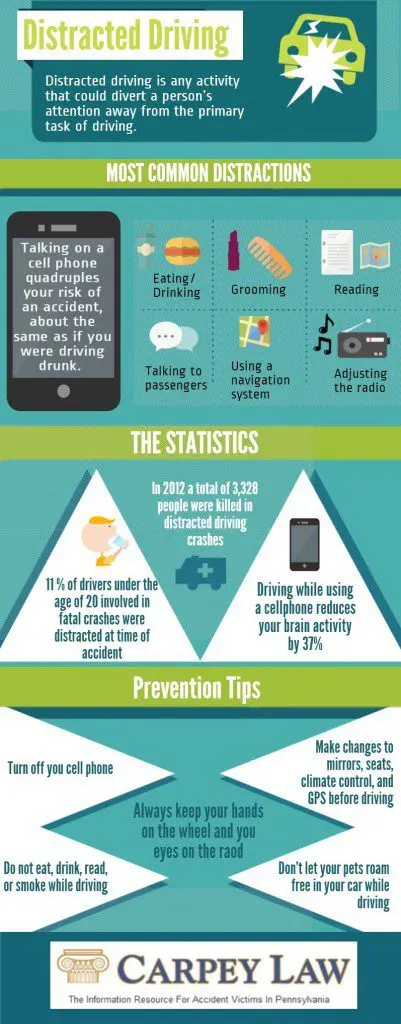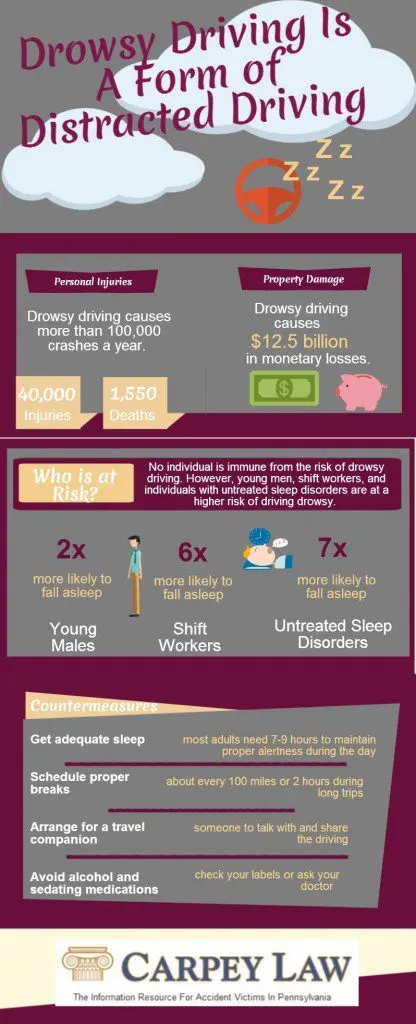Distracted driving accidents occur every day on the road. There are three ways a driver might become distracted:
- Cognitively. Allowing one’s mind to be focused on a thought or activity which reduces the attention given to driving.
- Manually. Engaging in an activity which causes one to remove one or both hands from the steering wheel.
- Visually. Engaging in an activity which causes one to take one’s eyes off of the road.
This article discusses:
- What is Distracted Driving
- Distracted Driving Statistics
- Distracted Driving Prevention
- Distracted Driving Laws
- Distracted Driving Law Enforcement
- Drowsy Driving
- What is AWZSE & How it Affects Your Driving Habits?
If you are involved in a Distracted Driving Accident, Contact Carpey Law
What Is Distracted Driving?
Distracted driving is described as any activity that could divert a person’s attention away from their primary task of driving, even for only a second. The most common examples include talking/texting on a cellphone, eating or drinking, using a GPS, adjusting the radio, putting on makeup, and talking to passengers.
Since it does not involve a foreign substance, many drivers are under the impression that distracted driving is a far less egregious offense than drunk driving. However, the facts show that simply isn’t true.
Not only does distracted driving put yourself in danger, but it also endangers other drivers, passengers and pedestrians on the road around you. Learn the facts and stats around distracted driving.
Distracted Driving Statistics
- At any given moment approximately 660,000 drivers are using their cellphones or manipulating an electronic device while driving.
- A driver’s brain activity associated with driving is reduced by 37 percent when he / she texts while driving.
- General use of a cell phone while driving makes a driver 4 times more likely to be involved in a crash.
- A driver using a cell phone while driving is impaired in much the same way as a driver who has a blood alcohol content (BAC) of .08.
However, use of cell phones isn’t the only form of distracted driving. Engaging in different tasks will affect a driver’s risk for an accident in different ways.
- A driver who is texting while driving is 23 X more likely to be involved in an accident.
- A driver who is dialing a number on a cell phone is 6 X more likely to be involved in an accident.
- A driver who is writing on a pad or notebook is 9 X more likely to be involved in an accident.
- A driver who is grooming him or herself while driving is 4 X more likely to be involved in an accident.
- A driver who is reaching for an object in the car is 3 X more likely to be involved in an accident.
- According to the Pennsylvania Department of Transportation, in 2018 distracted driving was a factor in 14,292 crashes and resulted in 63 fatalities representing 15.5% of all crashes.
- Generally, teens are the most likely to be distracted drivers and 10% of all drivers under the age of 20 involved in fatal crashes were distracted at the time of the accident.
- Drivers in their 20 make up 27% of all distracted drivers involved in fatal crashes.
- 10% of parents have admitted that they have extended, multi-message text conversation while driving.
- Of all fatal crashes involving drivers under the age of twenty-one, 11% were distracted at the time of the crash.
- In a recent study, 25% of teens admitted to answering a text message at least once every time they drive.
- Moreover, 20% reported having engaged in an extended, multi-message conversation while driving.
- The Administrative Office of Pennsylvania Courts (AOPC) reports that distracted driving citations have increased by 118% over the last five years.
- The National Highway Traffic Safety Administration’s (NHTSA) latest traffic accident statistics show that about 36,560 lives were lost in traffic accidents in 2018, with 2,841 or 7.8% attributed in some way to driver distraction.
- Studies showed the results of distracted driving are similar to driving with a blood alcohol content of .08!
The above-mentioned studies are only some of many scholarly endeavors intent on shedding light on the inherent dangers of distracted driving.
Distracted Driving Prevention
Legislation, though certainly a large step in the right direction, can only do so much. Here are a few basic steps you can take to help curtail distracted driving.
- Be smart. Don’t text and drive.
- Be courteous. Care about your friends and family. Don’t send a message or call them if you know they are driving.
- Be in control. Remember: it’s your phone. You can take control by turning it off while driving.
- Be an example. Whether you are with friends or family, remember that people are watching you. Make it a habit of not driving with your cell phone on.
The best way to end distracted driving is to educate everyone about its dangers. Passengers can also help to prevent drivers from driving distracted by offering to assist a driver who is attempting to multitask behind the wheel. Finally, as a driver you can take more active steps such as turning off your cell phone, avoiding eating or drinking, and making changes to mirrors, seats, and GPS before beginning to drive.
There are several mobile applications also designed to prevent or inhibit the use of mobile phones while driving. Here is a shortlist:
- Cellcontrol
- Securafone
- TextGauge
- DriveSafe.ly
- Phoneguard-anti-texting
- TeenSafer
- IZup
- Cell Safety
- Start Talking Hands-Free Texting
Distracted Driving Laws
Today, cell phone use represents the majority of distracted driving violations. In some states, technological distractions are covered by general distracted driving laws, while other states have enacted strict laws that forbid the use of a mobile phone without a hands-free device.
Some go even further and ban hands-free devices as well, at least for certain classes of drivers. Many states have also banned texting, including web browsing, emailing, and using smartphone apps.
On March 8, 2012, Pennsylvania banned texting while driving. Pennsylvania police say the law is very difficult to enforce. One reason for this is that drivers are still permitted to make calls on handheld mobile phones. With the ban on texting in place, the Pennsylvania legislature has introduced at least two bills seeking to ban cell phone use. Another proposed law would allow cities the option of making their own cell phone laws.
Distracted Driving Law Enforcement
Enforcement of these distracted driving laws varies as well. In most states, they’ve designated them as primary enforcement laws, which make it permissible for an officer to pull someone over for distracted driving alone. Secondary enforcement laws only allow citations for violating the distracted driving law if the driver was first pulled over for another violation.
While drivers can now be ticketed for texting while driving, the consequences can extend to far worse situations. If the driver causes an accident while texting or talking on the phone the charge could be bumped up to negligence or recklessness. Even if the accident was caused by someone else, the driver’s use of the cell phone could represent “contributory” or “comparative” negligence, meaning that the distraction didn’t help avoid the collision. In some cases, that negligent behavior could prevent the accident victim from receiving compensation for his or her injuries.
Proof of negligence is actually much easier now with the accessibility of electronic evidence from cell phone records. Records of cell phone usage are permissible in court as evidence, and they can be matched with the time of an accident, indicating that the driver was on using a cell phone when the accident occurred. If the driver was sending text messages or talking at the time of an accident, he or she inadvertently left a trail of electronic evidence that can be used to prove negligence.
Learn More about Distracted Driving Laws
Drowsy Driving
The dangers of driving without enough sleep are significant. According to the statistics, driving drowsy can be just as dangerous as driving drunk. Drowsy driving causes more than 100,000 crashes a year. As a result of these crashes, 40,000 individuals are injured and 1,550 individuals are killed. Oftentimes, these accidents result in single-car crashes in which the driver drifts out of his lane and off the road.
Every year, just over 100 million people fall asleep at the wheel, if only for a moment. This statistic was reported in a poll by the National Sleep Foundation’s, called Sleep in America. The poll reported that around 168 million Americans say they drive drowsy at least once a year, and about 11 million Americans say sleeping at the wheel caused a car accident or very nearly caused one.
The National Highway Traffic Safety Administration (NHTSA) reports that falling asleep at the wheel accounts for about 100,000 reported car accidents in the U.S. every year. This translates to a little over 1,500 deaths and 70,000 injuries. However, the numbers could be even higher — there is no easy way to determine whether or not a driver had fallen asleep at the wheel.
Of the main issues related to falling asleep at the wheel is that the driver is unsure of how to handle the problem. Often, a driver’s reaction exacerbates the situation. The National Sleep Foundation’s poll found that:
- 42% of the people who are falling asleep at the wheel begin to feel stressed.
- 32% of people who are falling asleep at the wheel become impatient with themselves and the drive.
- 12% of people who are falling asleep at the wheel drive faster so they may reach their destination before sleep takes them.
All of these reactions to falling asleep at the wheel can make the situation even more dangerous. Stress, impatience, and increased speed can affect a drowsy driver’s response time or cause him or her to make hasty or careless decisions.
Cases of falling asleep at the wheel have meant prison time for drivers who have harmed others in car accidents. Someone who falls asleep at the wheel is driving negligently.
Learn More About Negligent Driving Cases
In Carpey Law’s Drowsy Driving Infographic below, take a look at the startling statistics. No one is resistant to drowsy driving, though some groups of people are more prone to falling asleep at the wheel than others. Take precaution and make sure you are not putting yourself, your loved ones, and anyone else on the road at risk. It’s time we wake up to the risks drowsy driving can cause.
But these statistics do not tell the whole story. The National Highway Traffic Safety Administration has acknowledged that drowsy driving is highly underreported as a cause of an accident. Additionally, more than a third of drivers have reported nodding off while driving at some point in their lives.
Drowsy Driving Prevention
To combat drowsy driving, it is important to get a good night’s sleep, schedule breaks in your driving, travel with someone to share the driving, avoid alcohol, and avoid getting behind the wheel when you are tired or have taken sedative medications. Additionally, those who suffer from sleep apnea should seek medical treatment to help increase their sleeping habits and decrease their likelihood of drowsiness.
In addition to educating individuals and personal prevention, there are a number of different things we can do to help reduce instances of drowsy driving. For example, we can promote the use of shoulder rumble strips, which help alert a driver who is drifting off the road. Also, employers can manage shift worker’s schedules and take measures to prevent employees from driving while tired.
What is the AWZSE & How it Affects your Driving Habits?
PennDOT and the PA Turnpike enforced the statewide Automated Work Zone Speed Enforcement (AWZSE) program, in early April 2020. Now drivers must slow down and pay attention – especially in work zones. The new program uses “vehicle-mounted systems to detect and record” drivers exceeding work zone speed limits by 11 miles per hour. This will occur only in zones where workers are present. Violations will include:
- First Offence: Warning Letter
- Second Offence: Violation Notice and $75 fine
- Subsequent Offences: Violation Notice and $150
- NOTE that violations are civil penalties only; no points will be assessed to driver’s licenses. Violation notices will be sent to a registered vehicle owner within 90 days of the occurrence. If you were not driving the vehicle you are still responsible for paying the fine. If you want to contest the violation, instructions for doing so are in the letter.
You can find out more about the locations of the camera and get answers to your questions at PennDOT.
The reason PennDOT has put this program in place is to save lives. The goal is to change PA motorist’s unsafe driving behavior. In 2018, there were 23 motorists killed in PA work zones and 1,804 crashes. PennDOT and PA Turnpike workers have also been killed in work zones over the years. The states of Maryland and Illinois also have AWZSE programs. The money generated from the PA AWZSE program will pay for program operating expenses. If the program generates additional revenue after expenses are covered, it will be awarded as follows:
- For the first 3 years of the program:
- 45% goes to the Pennsylvania State Police (Recruiting, Training, and Equipment),
- 15% goes to the PennDOT or PA Turnpike Commission where the violation occurred, and 40% goes to the Motor License Fund.
- For years 4 and 5 of the program:
- 100% goes to PennDOT or PA Turnpike Commission areas where the violation occurred so they can use it to further develop a Work Zone and Highway Safety program.
- The staff at Carpey Law applauds this new program and hopes it works to change motorist behaviors in work zones, and any time they get behind the wheel.
Read Recent Articles by Carpey Law

Stuart A. Carpey, who has been practicing as an attorney since 1987, focuses his practice on complex civil litigation which includes representing injured individuals in a vast array of personal injury cases.


